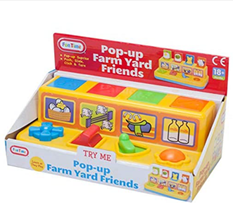June 27, 2022
Facts
Luen Fat Metal and Plastic Manufactory Co Ltd (LFM) manufactures toys, which have been imported into the UK since around 1989. Its sole agent and distributor for the UK and Ireland is Padgett Bros A to Z Ltd. LFM has owned a UK registered series of word trade marks for FUNTIME, FUN TIME and FUN-TIME since May 1997 covering “games, toys and playthings, and electronic games” in Class 28. It also owns a registered EU trade mark (EUTM) for FUNTIME, filed on 21 April 1998, covering the same goods (the Marks). Following Brexit, the EUTM now has a UK registered equivalent.
Below is an example of LFM’s Marks in use:

Funko UK Ltd was described as one of the world’s leading creators of licensed pop culture products. Funko takes IP licences from rights owners and makes and sells merchandise as spin-offs from games and films, e.g., Harry Potter merchandise. It sells a range of “Pop! Vinyl” figures, which are small plastic figures with an oversized square head depicting a character from a film, game, etc. Funko also sells action figures, which more accurately depict the characters, soft toys and board games, as well as ranges of clothing, homeware, etc. Funko accepted that the Pop! Vinyl figures and action figures were toys but said that some could also be classed as “collectibles”.
In 2015, Scottgames LLC, which owns the IP rights in the “Five Nights at Freddy’s” (FNAF) video game franchise, granted an IP licence to Funko. The games are popular with young teenagers (age 12 upwards), as well as adults. Funko described them as “fright video games … intended to scare the player …”.
The fifth game in the FNAF series, which was first launched in 2016, is called “Five Nights at Freddy’s: Sister Location”. It features the characters “Funtime Freddy” and “Funtime Foxy”. A range of action figures, Pop! Vinyls and plush toys representing the characters were developed by Funko during 2017 and sold in the UK by Funko, for example:

LFM issued proceedings against Funko for infringement of its Trade Marks under ss 10(1), (2) and (3) of the Trade Marks Act 1994 and Article 9 of the Trade Mark Regulation (207/2009/EC).
Funko denied infringement and said that the names “Funtime Freddy” and “Funtime Foxy” (the Names) were not used as trade marks, but to designate the characters from the computer game. It also denied that there was any likelihood of confusion or any damage to the Marks leading to infringement under s 10(3).
Decision
Proof of use
Funko put LFM to proof of use of its Marks. The evidence showed use in relation to and on the packaging of toys aimed predominantly at babies and toddlers (as shown in the example above). LFM did not distinguish between the three categories of goods, “toys, games and playthings”. Funko said that LFM had therefore only proved use in relation to “toys and playthings for babies and toddlers”.
Miss Recorder Amanda Michaels said that the evidence showed clear use of the UK Mark FUN TIME on the packaging of LFM’s goods. As there was no suggestion of any real distinction between FUN TIME and the other marks in the UK series, she accepted such use as use of all the Marks.
Recorder Michaels noted that “toys, games and playthings” were included in the Class 28 heading but found that LFM had not proved use across the whole spectrum of the specification. She held that a fair specification of the goods for which use had been shown, taking account of the perception of the average consumer, was “toys, games and playthings for babies and pre-school children”.
Distinctiveness
In Recorder Michael’s view, the inherent distinctiveness of the Marks in all three forms was low. She also disagreed with LFM that the Marks had acquired a high level of enhanced distinctiveness through use, as the evidence was insufficient. There was nothing on market share in the UK or elsewhere, and only scant evidence of sales in other EU Member States. Many of LFM’s goods were sold in packaging bearing the retailers’ own brands rather than the Marks, but there was no evidence of the proportions. Whilst the goods had FUNTIME moulded into the product itself, it was not clear whether this was visible at the point of sale. Further, there was no evidence as to how a consumer would perceive the moulded mark when the packaging bore a retailer’s mark. Finally, there was limited evidence of marketing and none of marketing spend. Accordingly, the enhanced distinctiveness gained through use was low.
Section 10(1)
Recorder Michaels rejected LFM’s argument that Funko’s consistent use of “Funtime” would result in the sign being perceived by the average consumer as FUNTIME. She also rejected the argument that use of “Funtime” alone in a single email passed amongst those developing the FNAF range showed that “Funtime” was the distinctive element of the Names. In Recorder Michael’s view, the average consumer would perceive the “Funtime” sign as part of the whole of the Names, i.e., a sign composed of two words, with “Freddie” and “Foxy” having a significant identifying role. Accordingly, the Names were not identical to the Marks and the claim for s 10(1) infringement was dismissed.
Section 10(2)
Recorder Michaels found that there was a medium level of visual and aural similarity between the Names and the Marks. A consumer would not ignore “Funtime” in the Names as being purely descriptive and adding “Freddy” or “Foxy” did not lead to a conceptual dissonance between the Names and the Marks, as Funko argued, although it added a further concept to the Marks. Accordingly, the Names were similar to the Marks to a medium degree.
Although some of Funko’s packaging referred to the goods as collectible items, that did not mean that they were not also toys. However, they were not toys designed for babies or pre-school children. Nevertheless, there was some evidence of Pop! Vinyls and action figures being bought for children aged ten to 14. They were also sold in the same outlets as LFM’s goods. Accordingly, Recorder Michaels found that Funko’s toy figures were not identical to LFM’s goods, as they were for older children, but they were similar to “toys for babies and pre-school children”. Funko’s plush toys depicting the characters, however, were identical.
As for whether the alleged infringing use was trade mark use, in Recorder Michael’s view, consumers familiar with the FNAF/Sister Location games might understand the use of the Names as descriptive and see the Funko branding and the name of the game as indicative of origin. However, not all average consumers would necessarily see the goods this way and at least some consumers might see the Names as indications of origin, especially if they were unfamiliar with the FNAF games and characters. To these consumers, the Names might be taken as use as a sub-brand, with an origin function.
As for likelihood of confusion, Recorder Michaels said that the context of the alleged infringing use encompassed the overall packaging and labelling of Funko’s goods, with its clear and prominent use of other brands, the lack of any evidence that Funko had used “Funtime” as part of a longer sub-brand, the fact that the Names were likely to be seen as the names of the figures (even if also seen as denoting origin) and the very real differences in the nature of the parties’ respective goods despite them being “similar” in terms of trade mark law. All these points militated against a likelihood of confusion.
Recorder Michaels rejected the argument that there was a real risk that the average consumer would think that LFM had licensed its Marks to Funko, i.e., that there would be an association in the mind of the consumer. She considered that the average consumer, who realised that Funko’s goods were licensed merchandise, would be more likely to associate them with the makers of the FNAF/Sister Location game, the names of which appeared prominently on the packaging, than with LFM because of the inclusion of “Funtime” in the Names.
The position was different for the plush toys, which could be seen as suitable for pre-school children. However, someone seeing a plush toy labelled in a similar manner to the figurines would be equally unlikely to assume that the use of “Funtime” was licensed by LFM. Further, some plush toys were not labelled with the Names (or just “Funtime”) at all.
Accordingly, Recorder Michaels found that there was no likelihood of confusion, even if the Names were seen as marks of origin. This view was reinforced by the lack of evidence of any confusion. The claim under s 10(2) therefore failed.
Section 10(3)
Recorder Michaels also dismissed the claim under this head. Although the Marks had a reputation, as the UK Marks had some enhanced distinctive character, there was no link between the Marks and the Names such that the relevant section of the public would make a connection between them even though it did not confuse them. Use of the Names on Funko’s goods would not bring the Marks to the mind of the average consumer. Consumers knowing of FNAF would see the use of “Funtime” as a reference to the FNAF characters, whilst consumers knowing of LFM’s range of goods would be unlikely to connect its Mark with Funko’s very different figurines. As for the plush toys, whilst identical to the fair specification for the Marks, there was no evidence that any soft toys had been sold by LFM, such that its reputation extended to those goods.
In case she was wrong, Recorder Michaels also set out her views on detriment under s 10(3). She rejected LFM’s argument that the “frightening” element of Funko’s products had an adverse impact on young children, such that a link with its own products was detrimental to its Marks. This argument was based on mere supposition, she said. The nature of the FNAF games did not mean that sales of Funko’s goods led to any risk of injury to the distinctive character of the Marks or in any way impeded LFM’s ability to use its Marks. Use of the Names would not bring LFM’s goods into disrepute.
In addition, there was no evidence that any advantage had been taken by Funko by its use of the Names. Even if there was a link made to the Marks by use of the Names, the success of Funko’s goods stemmed from the link to FNAF, not the link to the Marks. There was therefore no case of unfair advantage.
Finally, Recorder Michaels dismissed Funko’s argument that, in relation to due cause, it would rely on its licence from Scottgames. She found that if the Names had infringed, then the fact that Funko had been licensed by Scottgames was immaterial, as Scottgames was only able to licence use of its own IP rights and was not entitled to licence Funko to breach a third party’s IP rights. The claim was dismissed. (Luen Fat Metal and Plastic Manufactory Co Ltd v Funko UK Ltd [2022] EWHC 951 (IPEC) (27 April 2022) — to read the judgment in full, click here).
Expertise